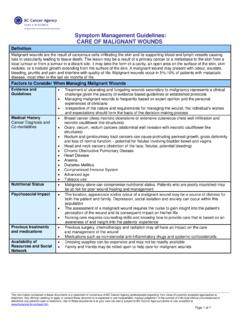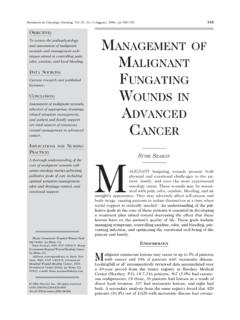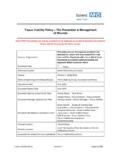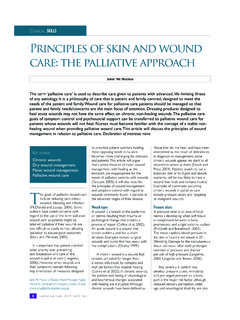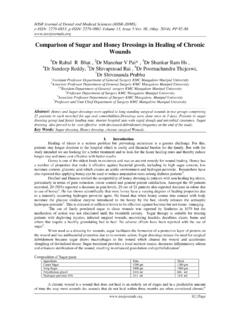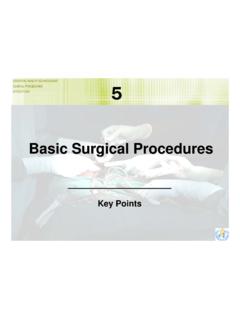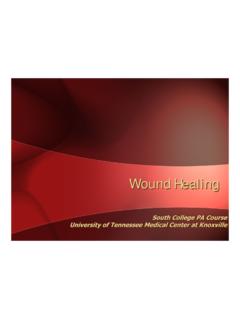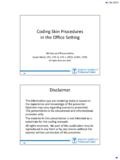Transcription of CLINICAL PROTOCOL FOR WOUND MANAGEMENT …
1 Multidisciplinary CP 04 June 2013 RATIONALE The aim of this document is to provide the appropriate MANAGEMENT strategy for optimum WOUND healing, patient comfort and cost effectiveness in line with best practice/evidence. All wounds must be assessed and reassessed by a competent registered health care professional who will undertake a comprehensive assessment of the WOUND (site, size, surface, grade and appearance, exudate type and volume, state of surrounding skin and level of WOUND pain) TARGET GROUP The procedures apply to all registered and non- registered health professionals within the Trust to provide WOUND care TRAINING All staff in the Trust are required to comply with mandatory training as specified in the Trusts Mandatory Training Matrix. CLINICAL Staff are also required to comply with service specific mandatory training as specified within their service training matrix.
2 RELATED POLICIES Please refer to relevant Trust policies and procedures, particularly the procedures for pressure ulcer care and leg ulcer care. TRUST WOUND CARE STANDARDS Complete one WOUND assessment form per WOUND to show progression of WOUND improvement or deterioration. Complete initial assessment and record baseline observations including respiration rate, pulse, temperature, blood pressure and urinalysis using the National Early Warning Score tool Reassessment of the WOUND should be undertaken at every dressing change, and documented on the Trust WOUND Assessment Chart at a minimum standard of weekly or more frequent depending on WOUND presentation using CLINICAL CLINICAL PROTOCOL FOR WOUND MANAGEMENT AND WOUND MANAGEMENT STANDARDS CLINICAL PROTOCOL for WOUND MANAGEMENT and WOUND MANAGEMENT Standards Page 2 of 17 Multidisciplinary CP 04 June 2013 judgement.
3 Supplementary information should be recorded on the evaluation forms, equipment or dressings to be ordered, etc. All initial wounds to be assessed and measured within the appropriate timeframe stated on the referral, or when clinically indicated using CLINICAL judgement Wounds must be swabbed if any signs of WOUND infection evident Swab results must be followed up and recorded on the WOUND assessment form All infected wounds (confirmed following a swab) must have topical Prontosan applied for a 15 minute soak at each intervention applied directly onto the WOUND ( once opened Prontosan has an eight week shelf life) Antimicrobial dressings must be reviewed and re-evaluated after 2-4 weeks of use The Tissue Viability Service must be contacted for specialist advice before further antimicrobial dressings are used following 2-4 weeks of application Pain must be assessed and evaluated at each visit, and recorded on the evaluation form.
4 All wounds remaining on the caseload longer than two weeks must be photographed and monthly thereafter, or as CLINICAL need indicates In the context of this PROTOCOL , the Malnutrition Universal Screening Tool (MUST) assessments should be completed for the following patients: All complex cases All pressure ulcers All leg ulcers Other wounds based on the health care professional s CLINICAL judgement to best meet the patient s holistic needs Nutritional status to be reassessed at least monthly or earlier if needed depending on CLINICAL need and MUST score Following MUST screening an appropriate individual nutritional care plan should be commenced and placed in the patient s notes and the Care Pathway to Identify and treat adults at risk of malnutrition should be followed. This should be monitored and regularly evaluated.
5 Always refer to the Trust s CLINICAL PROTOCOL for the Malnutrition Universal Screening Tool (MUST). The MUST will help identify adults who are malnourished, at risk of malnutrition or obese and screening should only occur if there is a CLINICAL concern (NICE 2006) CLINICAL PROTOCOL for WOUND MANAGEMENT and WOUND MANAGEMENT Standards Page 3 of 17 Multidisciplinary CP 04 June 2013 WOUND CLASSIFICATION A WOUND maybe defined as a defect or break in the skin that results from physical, mechanical or thermal damage, or that develops as a result of the presence of an underlying medical or physiological disorder (Thomas 1990) ACUTE WOUNDS Abrasions (grazes) are superficial wounds, generally caused by friction as a result of brief or indirect contact between the skin and a harder or rougher surface. Abrasions are generally confined to the outer layers of the skin.
6 Lacerations (tears) are more severe than abrasions and involve both the skin and the underlying tissues. Penetrating wounds maybe caused by knives, bullets or may result from accidental injuries caused by any sharp or pointed object. Internal damage can be considerable depending upon size and depth of penetration, and/or the velocity of the bullet or missile Bites caused by animals, insects or humans may become infected by a range of pathogenic organisms including Spirochetes, Staphylococci, Streptococci and various gram positive bacilli. If untreated these infections may have serious consequences, involving fascia, tendon and bone. BURNS AND CHEMICAL INJURIES There are several different types of burns: thermal, electrical and radiation. Thermal injuries are the most common. Burns and scalds (thermal) maybe classified into three types depending upon the degree of tissue damage.
7 Superficial (first degree) burns involve only the epidermis and superficial layers of the dermis and usually result from exposure to prolonged low intensity heat. Deep dermal (second degree) burns, in which most of the surface epithelium is destroyed together with much of the dermal layer beneath. Only some isolated epidermal elements in the deep layer remain visible such as those within hair follicles and sweat glands. Full thickness (third degree) burns, in which all the elements of the skin are destroyed CHRONIC WOUNDS Chronic wounds are the hard to heal wounds which are often linked to patients with CLINICAL PROTOCOL for WOUND MANAGEMENT and WOUND MANAGEMENT Standards Page 4 of 17 Multidisciplinary CP 04 June 2013 multiple co-morbidities and may never heal such as: Pressure ulcers which are usually caused by the sustained application of surface pressure over a bony prominence, which inhibits capillary blood flow to the skin and underlying tissue.
8 If the pressure is not relieved it will ultimately result in cell death followed by tissue necrosis and breakdown. Leg or foot ulcers, which maybe venous, ischaemic, mixed aetiology or traumatic in origin. Diabetic foot ulcers (require urgent referral to appropriate healthcare professional) Dermatological conditions Malignant/fungating wounds WOUND HEALING MECHANISMS Irrespective of the nature or type of WOUND , the same biochemical and cellular procedures are required to facilitate the healing process. Such methods of healing are: Primary Closure Primary closure is the usual method of choice for most clean surgical wounds and recent traumatic injuries. By a surgical technique the edges of the WOUND are individually sutured with the individual layers being brought together. Secondary Intention In wounds that have sustained a large amount of tissue loss as a result of surgery, trauma or chronic ulceration, it may be impossible to bring the edges of the WOUND together.
9 This is when the WOUND is left to heal by secondary intention. Delayed primary closure This is carried out when in the opinion of the surgeon, primary closure maybe unsuccessful (due to the presence of strikethrough, a poor blood supply to the area, or the need for the application of excessive tension during closure). In these circumstances the WOUND is left open for about three to four days before closure is completed. Grafting and flap formation A skin graft is a portion of skin (composed of dermis and epidermis) that is removed from one anatomical site and placed onto a WOUND elsewhere on the body. If successful, grafting will ensure that the WOUND will heal rapidly, thus reducing the chance of infection. The disadvantage of this technique is that the patient has two wounds instead of one and the donor site can be more painful than the original WOUND .
10 CLINICAL PROTOCOL for WOUND MANAGEMENT and WOUND MANAGEMENT Standards Page 5 of 17 Multidisciplinary CP 04 June 2013 INITIAL AND ONGOING WOUND ASSESSMENT Assessment should include information from different sources. It should bring together general and specific information on the patient, the skin, the circulation and the WOUND itself, only in this way can an accurate diagnosis be made. Holistic assessment of the patient is an essential part of the WOUND care process. WOUND BED PREPARATION The aim of WOUND bed preparation (WBP), a process described by Falanga (2000), is to create an optimal WOUND -healing environment. The core precept of WBP is to focus on both the WOUND and the patient as a whole. This approach will frequently require a multidisciplinary and structured approach to care delivery. Necrotic tissue WOUND containing dead tissue: It may appear hard, dry and black.

